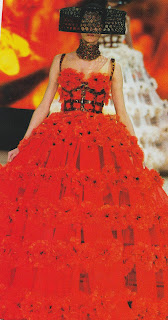Jennie Rayment 'The Calico Queen'
I went to one of Jennie's workshops at the V&A a few years ago. Her enthusiasm, humour, and freedom to experiment were inspiring and have led me here to this course.
Deepa Panchamia
This is the breathtaking version of folds and pleats...
 |
| Detail of folded textile by Deepa Panchamia on www.textilearts.net |
http://www.rowanmersh.com/
These two photos show some of the ways this English artist manipulates fabric, but there are many more, and often less obviously decorative - especially using rings or glass spheres to stretch it over. It's worth checking out the website.
 |
| Rowan Mersh Future Landscapes 2007 |
 |
| Rowan Mersh jewellery 2008-9 |
Department of Textilesmithing
'Textiles. Not just for fashion any more.
I'm not sure how useful this is, but it's very enthusiastic. There's a funny entry about the effect of various stimulant drugs on the weaving skills of spiders. It makes me think I could do something with weaving like a skider, rather than in squares or rectangles. I'm sure it's been done before - find out.
In fact there's a lot of value in trying it out first, to see what I come up with, rather than just copying other people's stuff. And then looking around to see what other people have come up with.
3d-woven-japanese-textiles-by-hosoo
Here is a link to a fantastic page of designboom which shows relief woven stingrays.
Again, this has made me think about how I could incorporate some kind of modified rug-making into embroidery.

Samira Boon - Dutch textile company
There's something very satisfying to me about these boxes with sides made of yarn, going off into the distance. You'd have to make a loom specially to do such a thing, with depth as well as width and length. I would love to see this hanging from one end and blowing in the air currents. What would that do to the light in and out of these pockets?
 |
| Samira Boon |
So I think this fabric is designed to absorb sound from all directions. Now that was not anything I thought of when I was compiling a list of uses of textiles under Maslow's hierarchy of needs. In fact, I stopped looking because there were just TOO MANY uses, especially in the top two or 3 sections of the pyramid.
Anyway, I like the regular lines + iinsect egg 3D shapes + square texture in different scales.
Perhaps I could try doing that - 3 contrasting shapes in different scales.
 |
| Acoustic fabric designed by Aleksandra Gaca for Casalis |




























































